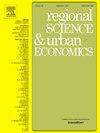Spillover effects of accessory dwelling unit development
IF 2.9
2区 经济学
Q1 ECONOMICS
引用次数: 0
Abstract
Promoting accessory dwelling units (ADUs), small residential backyard units, is one way that state and local governments have attempted to boost housing supply amid rising housing costs. However, homeowners worry about the impact on property values due to increased population and density. This paper studies the effect of ADU development on neighboring property values using an instrumental variable approach. I find that a 0.5 percentage point increase (the mean ADU concentration over the sample period of 2013–2021) in ADU density leads to a 3% decrease in nearby property prices. The negative spillover effects remain consistent within a 300-meter radius, after which they become statistically insignificant. The results are robust across alternative specifications and samples and the adverse effects of ADUs are more pronounced for properties with smaller lot sizes and those in low- and middle-rent neighborhoods. I provide evidence that ADU growth contributes to neighborhood externalities, including increased parking citations, domestic violence reports, illegal dumping, and neighborhood service requests, while showing no significant effects on overall or property crime.
附属住宅发展的溢出效应
在住房成本不断上升的情况下,推动小型住宅后院单元(adu)是州和地方政府试图增加住房供应的一种方式。然而,房主担心由于人口和密度的增加对房地产价值的影响。本文采用工具变量法研究了ADU开发对周边物业价值的影响。我发现,ADU密度每增加0.5个百分点(2013-2021年样本期间的平均ADU浓度),就会导致附近房价下降3%。负外溢效应在300米半径范围内保持一致,超过300米就变得不显著。结果在不同的规格和样本中都是稳健的,adu的不利影响对于较小的地块规模和中低租金社区的房产更为明显。我提供的证据表明,ADU的增长有助于社区外部性,包括增加停车罚单、家庭暴力报告、非法倾倒和社区服务请求,而对总体或财产犯罪没有显着影响。
本文章由计算机程序翻译,如有差异,请以英文原文为准。
求助全文
约1分钟内获得全文
求助全文
来源期刊

Regional Science and Urban Economics
Multiple-
CiteScore
5.30
自引率
9.70%
发文量
63
期刊介绍:
Regional Science and Urban Economics facilitates and encourages high-quality scholarship on important issues in regional and urban economics. It publishes significant contributions that are theoretical or empirical, positive or normative. It solicits original papers with a spatial dimension that can be of interest to economists. Empirical papers studying causal mechanisms are expected to propose a convincing identification strategy.
 求助内容:
求助内容: 应助结果提醒方式:
应助结果提醒方式:


